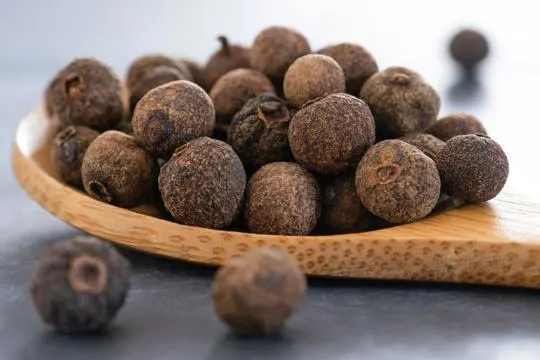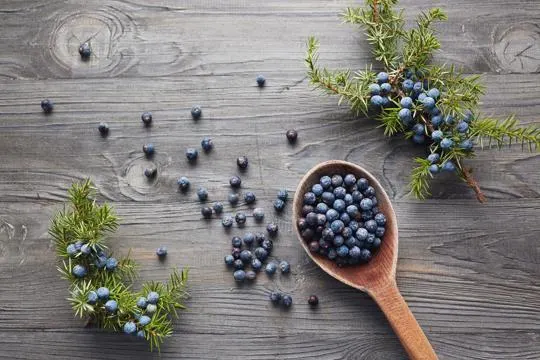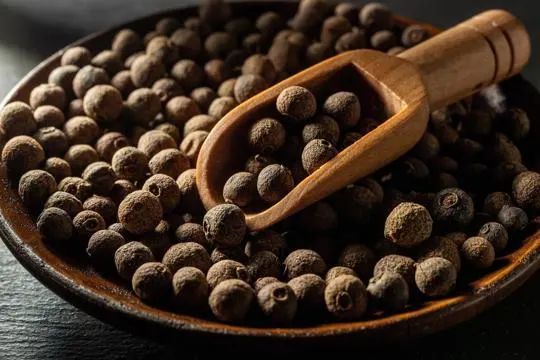Summary of key points
The primary difference between allspice and juniper berries is their origin and flavor profiles. Allspice, also known as pimento, is a dried berry from the Pimenta dioica tree native to Central America. It has a warm, spicy flavor with notes of cinnamon, nutmeg, and cloves. Juniper berries come from the juniper plant found in the northern hemisphere and have a distinct piney, citrus flavor with a slight bitterness. However, both are used as spices to add depth and warmth to dishes like stews, sauces, and marinades. The choice between allspice and juniper berries depends on personal preference and desired flavor profile for a dish. While allspice adds more sweetness and complexity, juniper berries bring a unique herbaceous taste.
Have you ever stood in the spice aisle, staring at allspice and juniper berries, wondering what on earth sets them apart? We’ve all been there.
Every Thanksgiving, my mom sends me on a spice hunt. It’s like a wild goose chase, but for flavors. Allspice? Juniper? To the untrained eye, they’re just tiny, smell-good spheres.
But oh, how different they play in our dishes. Ever thrown juniper berries into a stew and expected it to taste like your grandma’s allspice cake? Spoiler alert: it doesn’t.
We’re here to break down the mystery. Without the confusion. No culinary degree required. Just us, you, and some spice jars.
What is Allspice?

Allspice is a spice renowned for its warm and complex flavor.
It hails from the dried berries of the Pimenta Dioica tree, native to Central America.
People named it “allspice” due to its aroma – a mix of cinnamon, nutmeg, and cloves.
This fragrant spice can be used in both sweet and savory dishes.
For instance, it gives apple pie and gingerbread more depth, as well as enhances stews, marinades, and sausages.
It is a key ingredient in various global cuisines, such as Caribbean, Middle Eastern, and Mexican.
Apart from its culinary uses, allspice has also been linked to health benefits.
It is rich in antioxidants that may help protect against chronic diseases, like heart disease and cancer.
Plus, it has antimicrobial properties that can help preserve food.
What are Juniper Berries?

Juniper berries are small and blue-black.
They have a unique piney taste with citrus and pepper undertones.
These berries are widely used in cooking around the world.
Plus, they have medicinal properties and are high in antioxidants and anti-inflammatory elements.
Juniper berries are often used to give meat dishes, like venison and pork, a special flavor.
Also, they are an essential ingredient in the making of gin, which gives it that botanical taste.
So, if a recipe requires juniper berries, you know what to look for.
Differences Between Allspice and Juniper Berries

Allspice and juniper berries are two different spices with their own special flavors and uses in cooking.
Though they have some similarities, like their ability to make dishes smell great, there are major differences.
Flavor and Aroma
The flavor and aroma of allspice and juniper berries are different. Here’s the breakdown:
- Allspice: Warm and spicy, like a mix of cinnamon, nutmeg, and cloves. Its aroma is fragrant.
- Juniper Berries: Sharp and pine-like, with hints of bitterness. Aroma is fresh and woody.
Allspice shines in sweet dishes, adding depth and richness. Think pumpkin pie or apple cider.
Juniper berries bring a unique twist to savory dishes. Perfect for venison or duck.
Allspice is a harmonious blend. Juniper berries are more pronounced.
In conclusion, these ingredients let cooks explore taste.
Allspice brings warmth. Juniper berries offer piney notes.
Both are great for culinary creativity.
Culinary Uses
Allspice and juniper berries look similar, but have different culinary purposes.
Allspice has a warm, peppery taste.
So, it’s used in sweet treats like cakes and cookies.
Also, its aroma enhances savory dishes such as stews and curries.
Juniper berries, on the other hand, give off a piney, slight bitter flavor to game meats like venison and rabbit.
Gin production relies on the aroma of these berries.
Both allspice and juniper berries bring unique flavors to recipes, giving cooks endless possibilities.
Similarities Between Allspice and Juniper Berries

Allspice and Juniper Berries may look similar, but they differ greatly.
Both spices are known for their aromatic qualities and are used in many dishes.
Allspice comes from Central America and has flavors of cinnamon, nutmeg and cloves.
It can be found in berry or powder form.
Juniper Berries come from Europe and Asia.
They are dark purple and have a taste of pine and citrus.
They are used in game meats and sauerkraut.
Additionally, they are key ingredients in gin.
These two spices have a similarity – both have natural preservative properties from their essential oils.
The oils give flavor and help stop bacterial growth when preserving food.
Health Benefits and Nutritional Value Comparison
Health Benefits & Nutritional Value: Allspice vs Juniper Berries.
Allspice, also known as Pimenta dioica, is a spice from dried unripe berries of the Pimenta plant.
It is used in sweet and savory dishes, adding a warm and aromatic flavor.
It may aid digestion, and its antioxidants protect against free radicals.
Juniper berries come from Juniperus communis plants, with a pine-like flavor.
These berries are used in gin, and are praised for their diuretic properties, which may promote urinary tract health.
Allspice offers many vitamins and minerals, such as vitamin C, vitamin A, calcium, iron, magnesium, and dietary fiber.
Juniper berries contain vitamin C and essential minerals like potassium.
How to Use Allspice and Juniper Berries in Cooking
Cooking with allspice and juniper berries can bring a unique flavor to your food.
Here’s a 3-step guide on how to use them.
Enhancing flavors:
- Allspice: Use ground allspice in sweet and savory dishes. Its flavor is like a mix of cinnamon, nutmeg, and cloves. Add a pinch for extra depth in pies and gingerbread.
- Juniper Berries: These small, blue-ish berries have a piney, citrusy taste. Use them whole or crushed in marinades, sauces for game meats, or even roasted veggies and pickles.
Infusing liquids:
- Allspice: Tie some allspice in a cheesecloth or tea strainer before adding it to soups or stews. This’ll help keep the flavor in, and make it easier to remove the spice once it’s done.
- Juniper Berries: Infuse juniper into cocktails or non-alcoholic drinks like herbal tea. Crush a few berries and steep for a short period.
Pairing with other spices:
- Allspice: Try combining allspice with cinnamon, ginger, or cloves. Create flavorful rubs for meats or seasonings for vegetables.
- Juniper Berries: Use juniper with herbs such as rosemary, thyme, or bay leaves. This provides a harmonious taste experience.
Remember, a little goes a long way. Start small and adjust according to your taste.
By using these ingredients, you can take your flavors to a whole new level.
Conclusion
In summary, allspice and juniper berries are both delicious and aromatic ingredients that have been used in recipes throughout America since the late 19th century.
Although they come from different regions of the world, they share similarities in flavor and medicinal history that make them a popular choice for any dish.
The unique flavors of each ingredient, however, offer unique benefits making them two of the most sought after spices for any culinary enthusiast.
While these plants may share some characteristics, it is safe to say that when choosing between allspice or juniper berries, you can be sure to find an enjoyable combination regardless of what you choose.
So go ahead and experiment with flavor to create an unforgettable recipe.

Leave a comment